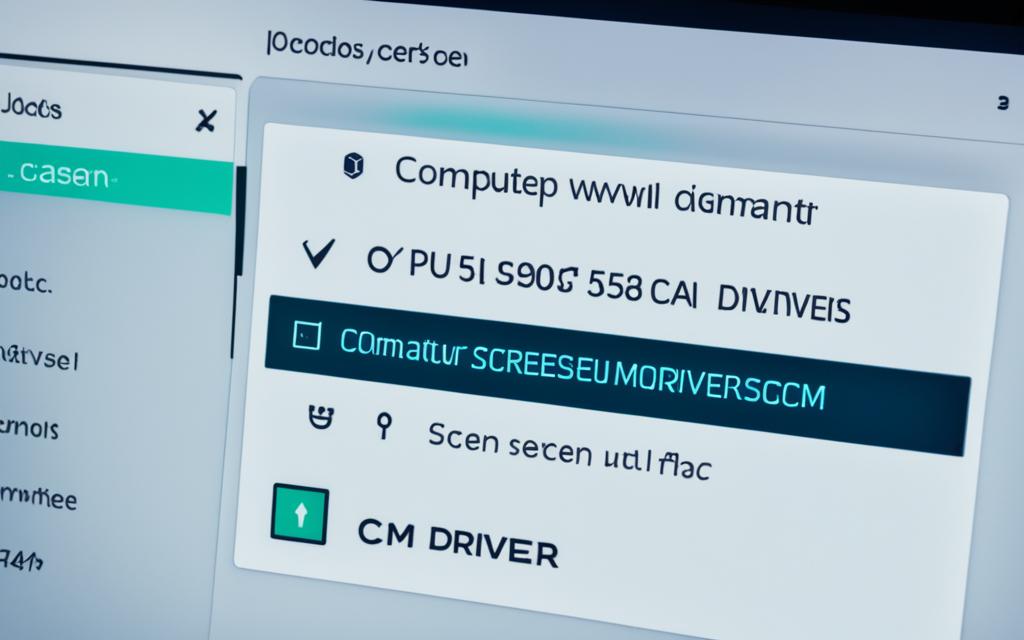Table of Contents
Keeping your CPU drivers updated is key in the fast-paced technology world. An updated driver boosts your system’s functionality, making operations smoother. Regularly checking your CPU drivers helps avoid problems like system crashes and slow performance.
This regular check is part of good computer maintenance. It matches practices recommended by Windows Update. This service makes it easier to keep drivers up-to-date.
Studies show that device drivers cause over 70% of computer crashes. So, it’s vital to keep your drivers updated for a stable system1. CPUs with integrated graphics get updates with their graphics cards. But CPUs without built-in GPUs need the motherboard BIOS for updates2. It’s important to update all components for the best performance.
Key Takeaways
- Regularly check CPU drivers to enhance system performance and prevent crashes.
- Windows Update can simplify the CPU driver updating process.
- Over 70% of PC crashes stem from outdated device drivers.
- Integrating graphics and CPU updates can streamline driver maintenance.
- Motherboard BIOS plays a critical role for CPUs without native GPUs.
Understanding the Importance of CPU Drivers
CPU drivers create a vital bridge between your computer’s brain and its system. They make sure your computer runs smoothly. Knowing about CPU drivers helps get the most out of your computer.
What are CPU Drivers?
CPU drivers are special programs that help your CPU talk to the system. They manage complex tasks, improving your computer’s speed and efficiency. While chips like the AMD Ryzen come with their own graphics support, most Intel chips rely on general drivers for good function3.
The Role of CPU Drivers in Computer Performance
It’s important to keep CPU drivers up to date for the best computer speed. Old drivers slow down your CPU, making your computer sluggish. Many don’t realize, but updating CPU drivers is as key as updating chipset drivers for top system speed and reaction.
Consequences of Outdated Drivers
Not updating drivers can really harm your computer. For instance, 70% of crashes are because of old drivers3. This risk makes it crucial to regularly update, especially for powerful computers.
| Consequences of Outdated Drivers | Description |
|---|---|
| Performance Degradation | System slows down and becomes less responsive. |
| System Crashes | Computer often crashes or restarts unexpectedly. |
| Software Incompatibility | Difficulty running new software properly. |
| Graphics Rendering Problems | Bad visuals in apps needing high-quality graphics. |
How to Check CPU Drivers
It’s important to check CPU drivers to keep your computer running smoothly. There are several ways to find out which driver version you have, ensuring everything works well. A common method is to access Device Manager. This Windows tool makes it easy to check and update your drivers.
Methods for Identifying Current Driver Versions
To check current driver versions, simply open the Device Manager. This feature lets you control hardware devices and see their drivers. By clicking on the ‘Processors’ area, you can see the CPU drivers installed. Regularly checking this helps you find outdated drivers. Manufacturers often update drivers to improve performance and fix problems5. Updating drivers helps avoid system crashes and improves efficiency6.
Accessing Device Manager to View Drivers
Getting to Device Manager is easy. You can right-click the Windows Start button or use the search bar. Once open, it shows all your hardware components. By selecting ‘Properties’ for the CPU, you get details on the driver version. Keeping this updated avoids slow performance or hardware issues5.
Updating CPU Drivers via Windows Update
Updating drivers using Windows Update is simple and keeps your CPU in top shape. Regular updates improve system performance and security. You’ll enjoy better system operations and enhanced protection.
Step-by-Step Process for Windows Update
To update your CPU drivers through Windows Update, just do the following:
- Open the Start menu and select Settings.
- Go to Update & Security.
- Click on Windows Update, then Check for updates.
- If updates are found, install them. Restart your computer if needed.
Benefits of Keeping Windows Updated
Windows Update has many benefits, such as:
- Keeping your hardware running smoothly
- Adding new features to improve your system
- Fixing bugs and enhancing stability
Updated drivers are crucial for your system’s health. They keep your computer stable and efficient. They prevent problems like system crashes and hardware issues. This helps your computer perform well every day78.
Downloading Drivers Directly from Manufacturer Websites
Getting CPU drivers from the manufacturer’s website is a sure way to keep your system running smoothly. To identify CPU manufacturer, you must know your hardware details. This makes finding the right drivers easy.
Identifying Your CPU and Motherboard Manufacturer
To find latest CPU drivers, learn the brands of your CPU and motherboard first. This step is key. It helps you find drivers that match your system’s needs. You can use system tools or check inside your computer to get this information.
Where to Find the Latest Drivers
After you identify CPU manufacturer, visit their website. Companies like Intel and AMD have special areas for downloading. There, you can find drivers for different CPU models and systems. Keeping up with these updates can make your computer faster and more reliable. It also helps prevent system errors.
| Manufacturer | Driver Download Page | Key Features |
|---|---|---|
| Intel | Intel Driver & Support Assistant | Automatic detection, security updates, performance improvements |
| AMD | AMD Driver Auto-detect Tool | Gaming optimisation, graphics enhancements, and stability patches |
| Nvidia | Nvidia Driver Downloads | Latest features, performance boosts, and compatibility updates |
By keeping your CPU drivers updated, your system will work better. This can lead to faster processing and better computer response. Updated drivers also reduce the risk of problems like crashes. This makes for a smoother experience910.
Using Device Manager for Driver Updates
Keeping your CPU drivers up to date is key for the best performance and security. Device Manager, a built-in Windows tool, makes it easy to manage and update drivers. In this part, we’ll show you how to navigate Device Manager and update CPU drivers yourself.
To start, look for Device Manager by searching in the Windows search bar. Open it from the search results. The Device Manager window shows all your computer’s hardware. Click on “Processors” to see your CPU devices and manage their drivers.
Updating Drivers Through Device Manager
Start by right-clicking on the CPU device you want to update and choose “Update driver.” Pick the option that lets Windows automatically search for driver updates. Windows will then look for and install any available updates.
If Windows finds a new driver, you’ll see a message confirming that your CPU drivers are up to date. Updating drivers is crucial to avoid hardware problems and improve system performance7. Since many crashes are due to driver issues, regular updates help keep your system stable1.
With Device Manager, you’re in charge of your driver updates. This approach helps your system run better and lowers the risk of problems2.
Reinstalling CPU Drivers for Optimal Performance
Reinstalling your CPU drivers can boost your computer’s performance. If you’re having problems like system crashes or slow responses, it’s time to reinstall. Knowing when to do this is key to keeping your system running smoothly.
When to Consider Reinstallation
Think about reinstalling your CPU drivers if you face:
- Frequent computer crashes or blue screens of death.
- Performance issues that don’t get better with regular updates.
- A major update to your operating system that might have upset driver compatibility.
- The addition of new hardware that needs specific drivers.
Step-by-Step Guide to Reinstalling Drivers
This guide on driver reinstallation provides simple steps to get the best CPU performance:
- Right-click the Start menu and pick Device Manager.
- Look for and open the Processors section to find your CPU.
- Right-click your CPU and choose Uninstall device.
- After uninstalling, reboot your computer. Windows will reinstall the drivers automatically.
- Post-restart, check for updates in Windows or visit the manufacturer’s website to ensure you have the latest drivers.
Correctly reinstalling CPU drivers can fix many issues and bring out the best in your device. Ensure the drivers match your Windows version to avoid future problems.
Conclusion
Checking and updating your CPU drivers regularly is key to keeping your computer performing well. This article showed different ways to update drivers. It explained why keeping drivers up-to-date is crucial to avoid problems like system crashes and slow performance11. By staying on top of driver updates, users will see better stability, improved multitasking, and enhanced compatibility with new apps and games. This leads to a more enjoyable computing experience12.
Using tools from manufacturers or Windows Device Manager makes updating drivers easier. It ensures your computer has the latest protections11. Regular maintenance boosts performance and security. It lets users feel confident in their technology use. For more tips on making your computer run better, check out this guide.
FAQ
What are CPU drivers?
CPU drivers help your operating system talk to the CPU. They make sure the CPU handles tasks well. This boosts your computer’s performance.
How do CPU drivers impact computer performance?
CPU drivers play a key role in task management and hardware communication. Keeping them up-to-date improves speed, reduces crashes, and offers a better experience.
What are the consequences of outdated CPU drivers?
Having old drivers can cause slowdowns, crashes, and issues with new software. Reports show 70% of crashes come from outdated drivers.
How can I check my current CPU driver version?
To see your driver version, go to Device Manager from the Start menu. Click ‘Processors’ to find your CPU and check its driver info.
What is the process for updating CPU drivers via Windows Update?
Update drivers by going to ‘Update & Security’ in Windows Settings. Look for updates to get the latest driver versions.
What are the benefits of keeping Windows updated?
Updating Windows keeps your drivers fresh. It also boosts your PC’s speed, fixes errors, and strengthens security.
How can I download CPU drivers directly from the manufacturer’s website?
First, know your CPU and motherboard’s make. Then, visit their websites to get the newest drivers for your gear.
Right-click the Start menu to find Device Manager. Here, you can update your CPU’s drivers easily.
When should I consider reinstalling CPU drivers?
If you keep having crashes or slow performance, try reinstalling your drivers. It might fix these issues.
What is the step-by-step guide for reinstalling CPU drivers?
In Device Manager, right-click the CPU and choose ‘Uninstall device’. After restarting, Windows will put the driver back by itself.
Source Links
- https://www.ccleaner.com/ccleaner/how-to-update-cpu-drivers – How to update CPU drivers | CCleaner
- https://www.partitionwizard.com/partitionmagic/how-to-update-cpu-drivers.html – [Step by Step] How to Update CPU Drivers Windows 10/11? – MiniTool Partition Wizard
- https://www.digitaltrends.com/computing/do-cpus-require-drivers/ – Do CPUs require drivers? | Digital Trends
- https://toolbox.easeus.com/driverhandy/update-cpu-driver.html – How to Update Your CPU Driver and Boost Your Computer’s Performance
- https://softwareg.com.au/blogs/computer-hardware/how-to-check-cpu-driver-version – How To Check CPU Driver Version
- https://www.pcguide.com/cpu/how-to/update-drivers/ – How to update CPU drivers – 2 methods (with pictures)
- https://helpcenter.trendmicro.com/en-us/article/tmka-11234 – How to Update Windows Device Drivers: Step-by-Step Guide
- https://softkeys.uk/blogs/blog/how-to-update-cpu-drivers-windows-10 – How to Update Cpu Drivers Windows 10?
- https://www.jawa.gg/blog/how-to-update-cpu-drivers/ – How to Update CPU Drivers
- https://www.avg.com/en/signal/how-to-update-graphics-drivers – How to Update Graphics Drivers in Windows 11, 10, 8, and 7
- https://softwareg.com.au/blogs/computer-hardware/how-to-check-for-cpu-driver-updates – How To Check For CPU Driver Updates
- https://ms.codes/blogs/computer-hardware/intel-core-i7-cpu-driver-update – Intel Core I7 CPU Driver Update








